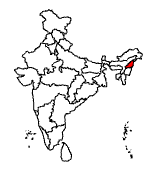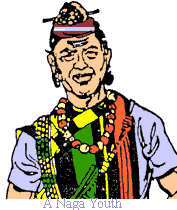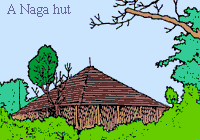
Dimdima
Online Children's Magazine from India

Dimdima
Online Children's Magazine from India
Area : 16579 square kilometres
Population : 19,88,636.
Capital : Kohima.
Location :
Nagaland in India's northeast, is a narrow strip of territory.
Physiography :
The Naga Hills run through this small state, with Saramati, its highest peak reaching a height of 3841 m. These mountains have some of the richest forest cover left in India.
People :
There are many distinct tribes and sub-tribes among the Nagas, each with its distinctive language and cultural features. Prominent among these are the Kukis, Angamis, Aos, Konyaks, Lothas, Semas and Wanchus. In earlier days, these tribes were known for their fierceness and the periodic raids they made into the neighbouring areas.
Though several towns have developed in the last few decades, the people live mainly in the villages. The main structure in every village is the morung, a narrow elongated building that serves as a storehouse for weapons and a dormitory for the warriors.
Occupation :
For long, the slash and burn techniques of jhum cultivation was followed. Though, only a little more than one-third of the total area in the state is cultivable, agriculture is the mainstay of the economy with 90% of the population involved in it. Development organizations and government initiatives have encouraged the people to adopt terraced cultivation, farm forestry and to plant orchards.
Popular occupations also include sericulture and bee keeping. The Nagas manufacture exquisite artefacts with the simplest of equipment, home made colours and bamboo. Weaving is a traditional art handed down through generations in Nagaland.
Women stitch together strips of colourful cloth to produce shawls in distinctive patterns, each pattern being associated with a particular tribe.
The name "Naga" is derived from the Burmese word "Naka ", meaning "people with perforated ears." The Nagas, who pierced their ears to accommodate big wooden plugs and other ornaments, were given this name as they passed through Burmese territory during their migration from southern China to the Naga Hills. During 1819 to 1832, the Burmese tried to extend their rule in the northeast. But the British in a series of wars against the Burmese eventually annexed the Naga Hills where the Nagas lived.
British occupation brought many deep-rooted changes in Naga life. Spread of education led to increased political awareness. The introduction of English enabled the different tribes to develop a coherent identity, around a common language.
There was disaffection in certain sections. In 1862, the Kukis from the hills devastated a vast region in Tippera, killing nearly 300 people. A British military force penetrated into the Kuki country and destroyed the village of the ringleader. A second Kuki raid was repulsed with heavy losses in 1863.
In the 1920s, the Nagas united under Haipou Jadonang, who stressed the importance of education, and the need to discard superstition. In 1931, he began a Naga civil disobedience - the Zeliangrong Movement in the Naga Hills and proclaimed Naga Raj. Arrested, he was hanged by the British on the false charge of murdering some traders.
The infuriated Nagas chose his 15-year-old niece, Gaidinlu, as their leader. She organized an army and a network of spies to report every movement of the British troops to her and urged the Nagas to withhold taxes.
The British finally captured her on 17 October 1932. As she refused to withdraw the agitation, she was thrown into prison where she languished till India's independence in 1947.
Nagaland became a full-fledged state of the Indian Union in 1963.
Kohima, the capital of Nagaland, is a hill station which became famous during World War II as the place where the Japanese advance was halted in April 1944. The War Cemetery that was originally a tennis court,
and the Memorial, record the sacrifices made by a handful of soldiers against the Japanese. An inscription there reads: "When you go home, tell them of us and say, for your tomorrow we gave our today."
Though Nagaland is a landlocked state with no direct access to the sea, some old Naga folktales relate to the sea, suggesting that their ancestors might have been a seafaring people. Seashell jewellery is on view at Kohima's state museum where one can also see a huge drum resembling a war canoe of Polynesian design.
The Catholic cathedral on Aradura Hill in Kohima is one of the biggest cathedrals in the Northeast. It houses the biggest wooden cross in India. The Dzakou Valley – the "Valley of Eternal Charm" has striking foliage of evergreen cane, rare orchids and rhododendron. The valley's crisp, cool air, meandering streams and flora attract several trekkers. The Japfu Peak presents an enchanting view of Kohima.
The Intaki Wildlife Sanctuary near Dimapur, one of Nagland's major towns, has some of the world's rarest species of animals and birds.
Ruzaphema, a small town has colourful bazaars and a wide range of tribal handicrafts. Mokukchung is another picturesque town and the old capital of the Ao Nagas.
Music and dance are very important to the Naga culture. Dressed in bright tribal gear, bearing shields and spears, the Nagas love to perform war dances, especially during festivals. The festival of Sekrenyi is celebrated by some tribes during February, when all work in the fields cease. Moatsu, observed by the Ao tribes in May is a 6-day festival marking the beginning of the sowing season.



Dimdima is the Sanskrit word for ‘drumbeat’. In olden days, victory in battle was heralded by the beat of drums or any important news to be conveyed to the people used to be accompanied with drumbeats.
Bharatiya Vidya Bhavan
K. M Munshi Marg,
Chowpatty, Mumbai - 400 007
email : editor@dimdima.com
Bharatiya Vidya Bhavan
505, Sane Guruji Marg,
Tardeo, Mumbai - 400 034
email : promo@dimdima.com
Dimdima.com, the Children's Website of Bharatiya Vidya Bhavan launched in 2000 and came out with a Printed version of Dimdima Magazine in 2004. At present the Printed Version have more than 35,000 subscribers from India and Abroad.